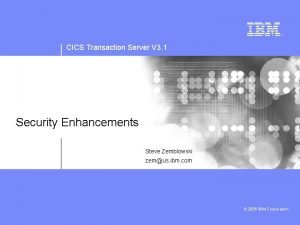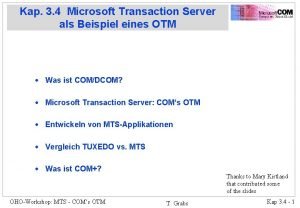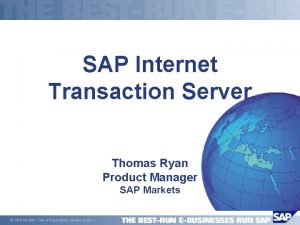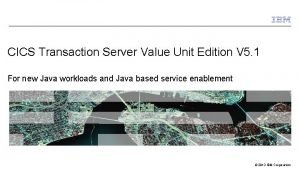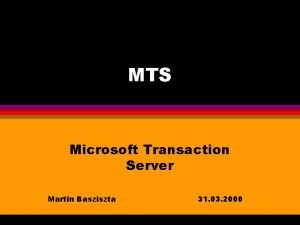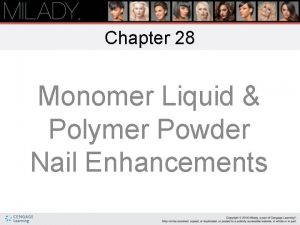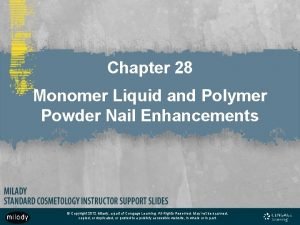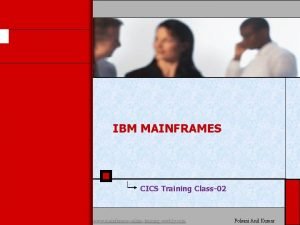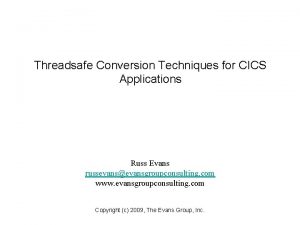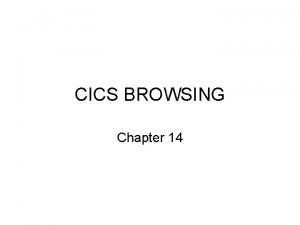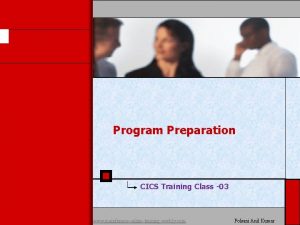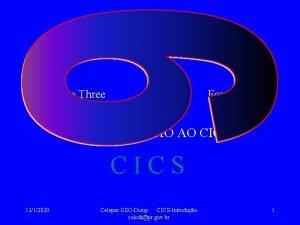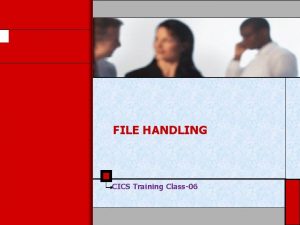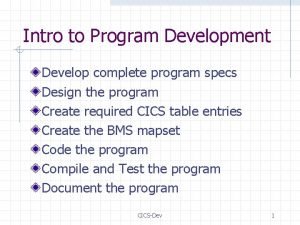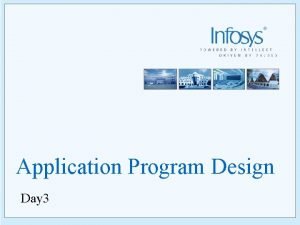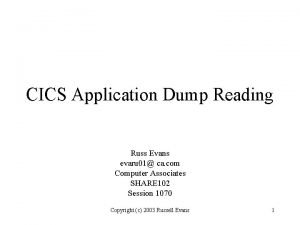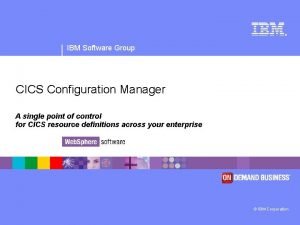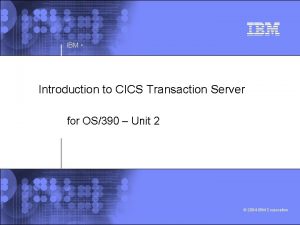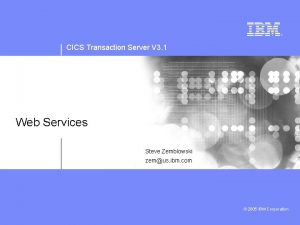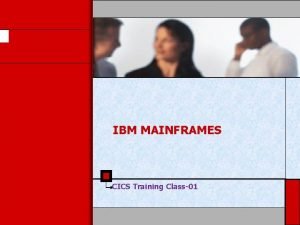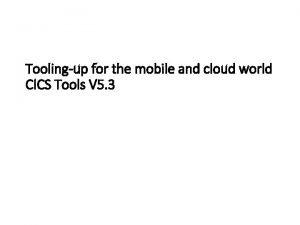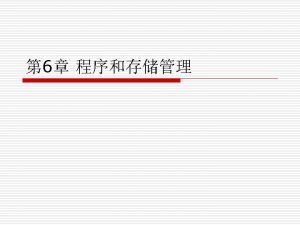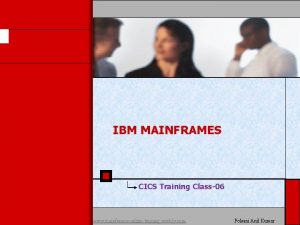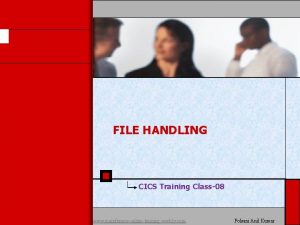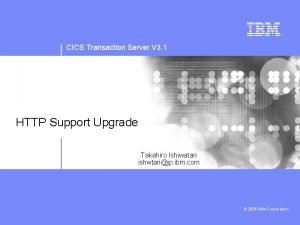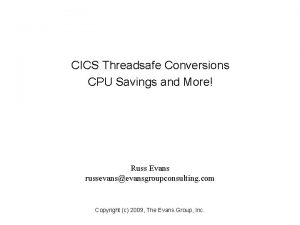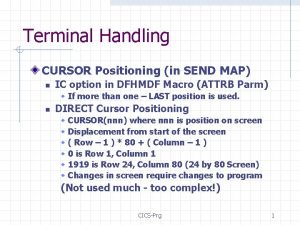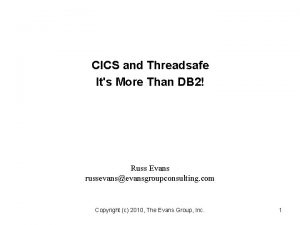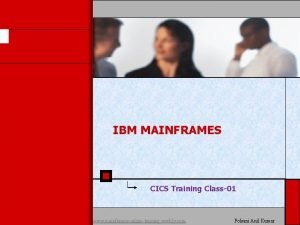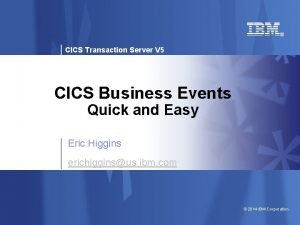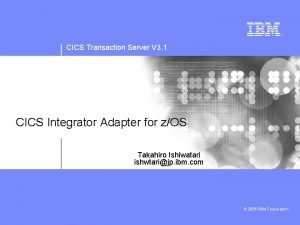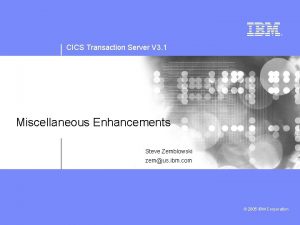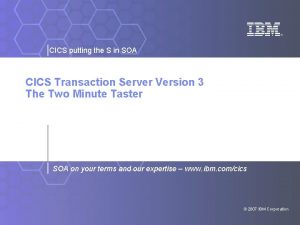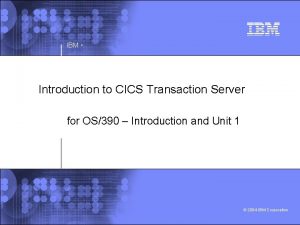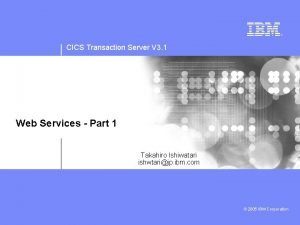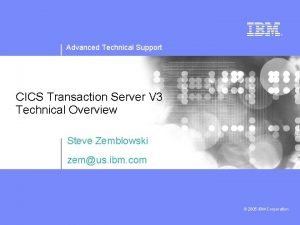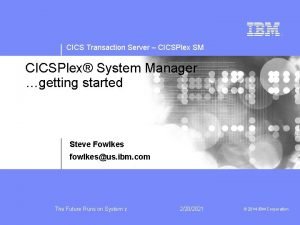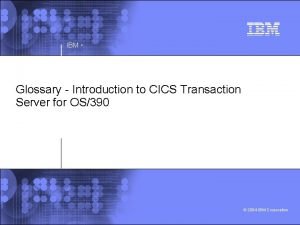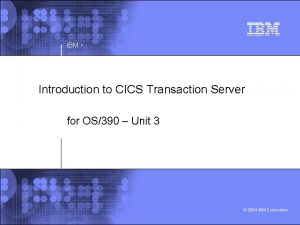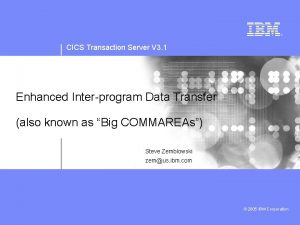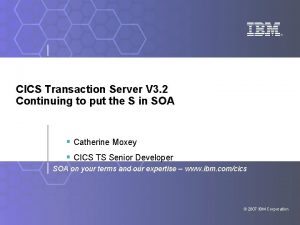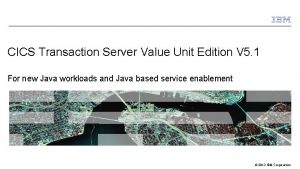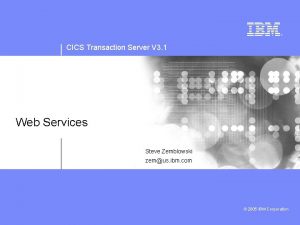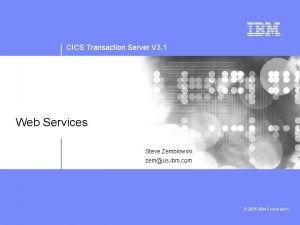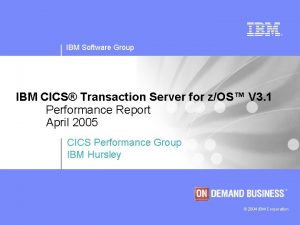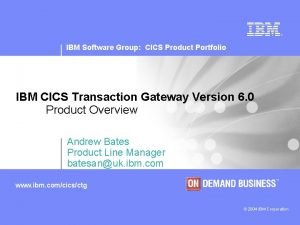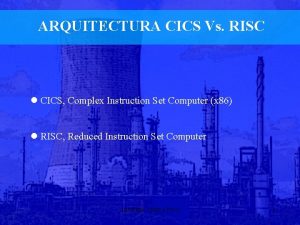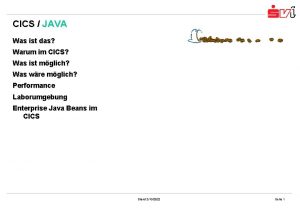CICS Transaction Server V 3 1 Enhancements for




















































- Slides: 52

CICS Transaction Server V 3. 1 Enhancements for Open Transaction Environment Takahiro Ishiwatari ishwtari@jp. ibm. com © 2005 IBM Corporation

CICS Transaction Server V 3. 1 Enhancements for OTE - Notes This presentation will describe the capabilities provided by Open Transaction Environment (OTE) Stage 3 in CICS Transaction Server 3. 1. 2 © 2005 IBM Corporation

CICS Transaction Server V 3. 1 Acknowledgements § The following are trademarks of International Business Machines Corporation in the United States, other countries, or both: IBM, CICS/ESA, CICS TS, CICS Transaction Server, DB 2, MQSeries, OS/390, Web. Sphere, z/OS, z. Series, Parallel Sysplex. § Java, and all Java-based trademarks and logos, are trademarks of Sun Microsystems, Inc. in the United States, other countries, or both. § Microsoft, Windows NT, and the Windows logo are trademarks of Microsoft Corporation in the United States, other countries, or both. § Other company, product, and service names and logos may be trademarks or service marks of others. 3 © 2005 IBM Corporation

CICS Transaction Server V 3. 1 Enhancements for OTE - Notes This page intentionally left blank. 4 © 2005 IBM Corporation

CICS Transaction Server V 3. 1 Agenda § OTE Stage 3 – Full OTE exploitation – XPLink for C/C++ applications § New threadsafe APIs 5 © 2005 IBM Corporation

CICS Transaction Server V 3. 1 Enhancements for OTE - Notes There are three major enhancements in the Open Transaction Environment area. First is the full OTE exploitation, which allows non CICS-DB 2 applications to run on open TCBs. The second is for C/C++ applications using the XPLink compile option. It is implemented by executing those programs on open TCBs. The last is support for additional threadsafe APIs. 6 © 2005 IBM Corporation

CICS Transaction Server V 3. 1 Open Transaction Environment § Enables applications to run on their own TCB • Benefits – Possible throughput increase by > utilizing multiple processor environments > reducing CPU costs with fewer TCB switches in CICS-DB 2 applications > relieving QR TCB from CPU intensive workloads > reduce contention on QR TCB 7 © 2005 IBM Corporation

CICS Transaction Server V 3. 1 Enhancements for OTE - Notes OTE enables applications to run on their own TCBs other than the main CICS TCB (the quasireentrant or QR TCB). These TCBs are called open TCBs. Using open TCBs, transactions can execute concurrently with other transactions, utilizing multiple processor environments. It can reduce TCB switches in CICS-DB 2 applications lowering CPU costs. CPU intensive workloads can be moved off of the QR TCB, reducing contention of the QR TCB. The capabilities of OTE can provide improved performance of the CICS system. 8 © 2005 IBM Corporation

CICS Transaction Server V 3. 1 History of Open Transaction Environment § Stage 1 : CICS TS V 1. 3 • Java application running on open TCBs – JVM programs on J 8 TCBs > executed in CICS key (key-8) – Java program objects (HPJ programs) on H 8 TCBs • some CICS APIs made threadsafe § Stage 2 : CICS TS V 2 • CICS-DB 2 applications can run on open TCBs – COBOL, PL/I, C/C++, Assembler programs with DB 2 access – runs on L 8 TCBs – move to L 8 TCB initiated by SQL requests > CICS-DB 2 attachment exploiting OPENAPI support for TRUEs – CONCURRENCY(THREADSAFE) in PROGRAM definition • J 9 TCBs for USER key java applications • more APIs made threadsafe 9 © 2005 IBM Corporation

CICS Transaction Server V 3. 1 Enhancements for OTE - Notes The OTE has been implemented in stages. It was first introduced in CICS TS 1. 3. It allowed java applications run on their own TCB. Java transactions which run on a Java virtual machine uses J 8 TCBs. Subsequently, support was added for hot-pooled HPJ programs (programs compiled from byte code to executable code with the High Performance Java compiler) to run on H 8 TCBs. In CICS TS 1. 3, some of the APIs and SPIs were made threadsafe, and enabled those commands to execute on open TCBs. In CICS TS V 2. 2, OPENAPI support for task related user exits (TRUEs) were added. CICS-DB 2 attachment exploited this support, enabling CICS-DB 2 applications to run on open TCBs. When an program issued an EXEC SQL request, it would switch to L 8 TCBs and execute the SQL request. After completion of the SQL request, the program will stay on the L 8 TCB and execute its logic. If another SQL request is issued, there will be no TCB switching. It will return to the QR TCB when the program issues a non-threadsafe EXEC CICS command. The CONCURRENCY(THREADSAFE) in the program definition indicates that the program is eligible for execution on the open TCB. In CICS TS V 2. 3, EXECKEY(USER) was honored for java applications. Those programs would run on J 9 TCBs. Additionally, EXEC CICS ASKTIME, FORMATTIME and DOCUMENT APIs were made threadsafe. 10 © 2005 IBM Corporation

CICS Transaction Server V 3. 1 TCB switching in CICS TS V 2 QR TCB L 8 TCB QR TCB Program start EXEC CICS threadsafe EXEC SQL EXEC CICS threadsafe EXEC CICS non-threadsafe EXEC SQL EXEC RETURN CONCURRENCY(QUASIRENT) 11 L 8 TCB CONCURRENCY(THREADSAFE) © 2005 IBM Corporation

CICS Transaction Server V 3. 1 Enhancements for OTE - Notes This is an example of the TCB switching in CICS TS V 2. When the program is defined as CONCURRENCY(QUASIRENT), the program will start on the QR TCB and run until an EXEC SQL command. The program will switch to an L 8 TCB, execute the SQL request and then return back to the QR TCB. Each SQL request will have two TCB switches. When the program is defined as CONCURRENCY(THREADSAFE), the program will start on the QR TCB and run until an EXEC SQL command. The program will switch to an L 8 TCB, execute the SQL request but will stay on the L 8 TCB after completion. Application logic will run on the L 8 TCB and when there is another SQL request there will be no TCB switching. Threadsafe EXEC CICS command will run on L 8 TCB. Issuing non-threadsafe EXEC CICS commands will take the application back to the QR TCB. It will stay on the QR TCB until another SQL request is issued, and then switch to the L 8 TCB again. With CONCURRENCY(THREADSAFE), the number or TCB switches will decrease saving processor time, and providing increased performance. 12 © 2005 IBM Corporation

CICS Transaction Server V 3. 1 Threadsafe programs § capable of being invoked on multiple TCBs concurrently § uses serialization techniques to access shared resource • serialization techniques in CICS – – Compare and Swap instruction Issue ENQ on the resource LINK to a QUASIRENT program use TRANCLASS definition MAXACTIVE(1) § Preparing for threadsafe applications • Compile and link-edit with RENT option • Run DFHEISUP to detect possible unthreadsafe resource usage – DFHEIDTH > EXTRACT EXIT GASET, ADDRESS CWA, GETMAIN SHARED – DFHEIDNT > use of non-threadsafe APIs • Serialize access to shared resource • Check that Exits and URMs are also threadsafe § For more information • Redbook : Threadsafe Considerations for CICS (SG 24 -6351) 13 © 2005 IBM Corporation

CICS Transaction Server V 3. 1 Enhancements for OTE - Notes In order to take advantage of OTE, the programs must be threadsafe. Threadsafe programs are programs that are capable of being invoked on multiple TCBs concurrently. When the program accesses shared resource such as CWA and GETMAIN SHARED, the program needs to be sure that those resources are accessed in a serialized manner. If they are not serialized, there will be a risk of losing integrity. Some of the serialization techniques in CICS are using compare and swap instructions, issuing EXEC CICS ENQ before accessing the resource, LINK to a QUASIRENT program, and using MAXACTIVE(1) in the TRANCLASS definition. To make applications threadsafe you should - Compile and link-edit with the RENT option - Run the load module scanner to detect possible non-threadsafe resource usage - Serialize access to shared resource - Check that exits and URMs are also threadsafe Redbook “Threadsafe considerations for CICS” has detailed information about exploiting OTE and making applications threadsafe. 14 © 2005 IBM Corporation

CICS Transaction Server V 3. 1 CICS TS V 3. 1 : Full OTE exploitation (Stage 3) § Applications can run on open TCBs from the start • Benefits – More application logic to move off of QR TCB, exploit OTE > non CICS-DB 2 applications > CPU intensive applications > Application logic before the first SQL call • TCB switch to L 8 or L 9 on invocation – New L 9 TCB for USER key programs – L 8, L 9 TCBs controlled by MAXOPENTCBS SIT parameter – use of non threadsafe APIs will switch to QR TCB and back > switch back from QR TCB on completion of request • New API attribute in PROGRAM definition – API ( CICSAPI | OPENAPI ) > CICSAPI : program starts on QR TCB > OPENAPI : program starts on L 8 or L 9 TCB – OPENAPI implies CONCURRENCY(THREADSAFE) > Applications need to be threadsafe! > FORCEQR will not effect OPENAPI programs 15 © 2005 IBM Corporation

CICS Transaction Server V 3. 1 Enhancements for OTE - Notes With OTE Stage 3, you can make applications run on open TCBs from the start. This will enable more application logic to move off of the QR TCB, such as non-CICS-DB 2 applications, CICS-DB 2 applications that have a large amount of work before the first SQL, applications that are CPU intensive. The TCBs that are used will be L 8 or L 9 TCB. L 8 TCB, which was introduced in CICS TS V 2. 2, will run programs that are defined as CICS key. L 9 TCB, which is a new TCB, will run programs that are defined as USER key. Both L 8 and L 9 TCBs will be controlled in the same TCB pool, and the maximum number of TCBs in the pool can be specified with MAXOPENTCBS parameter in the SIT. The difference with previous open TCB usage is that when the program is running on L 8 or L 9 TCB and issues a non-threadsafe API, CICS will switch to the QR TCB to execute the non-threadsafe API, and when the API processing is complete the program will be switched back to the L 8 or L 9 TCB which it was running on. To enable this, there will be a new attribute in the PROGRAM definition called API. It can have values of CICSAPI or OPENAPI. For API(CICSAPI), the program will start on the QR TCB. The processing will be the same as in previous releases. For API(OPENAPI), the program will start on L 8 or L 9 TCB depending on the EXECKEY setting. Specifying OPENAPI will enforce CONCURRENCY(THREADSAFE). Applications running with OPENAPI must be coded to threadsafe standards. The FORCEQR=YES specification in SIT will not have an effect on OPENAPI programs. 16 © 2005 IBM Corporation

CICS Transaction Server V 3. 1 TCB switching enhancements in CICS TS V 3 QR TCB L 8 TCB Program start EXEC CICS threadsafe EXEC SQL EXEC CICS threadsafe EXEC CICS non-threadsafe EXEC CICS threadsafe EXEC SQL EXEC RETURN THREADSAFE with CICSAPI 17 THREADSAFE with OPENAPI © 2005 IBM Corporation

CICS Transaction Server V 3. 1 Enhancements for OTE - Notes This shows the TCB switching with OTE stage 3. The left diagram shows the TCB switching with CONCURRENCY(THREADSAFE) and API(CICSAPI). This is the same as the CONCURRENCY(THREADSAFE) in previous releases. The right diagram shows the TCB switching with CONCURRENCY(THREADSAFE) and API(OPENAPI). The program will switch to L 8 or L 9 TCB on invocation, in this case L 8 TCB, meaning the program specified EXECKEY(CICS). Threadsafe APIs will run on the L 8 TCB, and SQL requests will also run on the L 8 TCB without having any TCB switching. When the program issues a non threadsafe API, the TCB will switch to QR TCB and process the API. On completion of the API the TCB will be switched back to the L 8 TCB. 18 © 2005 IBM Corporation

CICS Transaction Server V 3. 1 Considerations § Use of non-CICS APIs • considered to be unsupported – “Use of other (non CICS) APIs within CICS is entirely at the discretion and risk of the user. No testing of other (non CICS) APIs within CICS has been undertaken and use of such APIs is not supported by IBM Service. ” (Release Guide) § TCB switching • SQL requests will process on L 8 TCBs – For EXECKEY(CICS) programs > no TCB switching will occur – For EXECKEY(USER) programs > TCB will switch from L 9 to L 8 > will return to L 9 on completion of the SQL request • Non-threadsafe API calls – many non-threadsafe calls may degrade performance when running with OPENAPI > compared to CICSAPI threadsafe programs 19 © 2005 IBM Corporation

CICS Transaction Server V 3. 1 Enhancements for OTE - Notes Use of other (non CICS) APIs in OPENAPI programs is possible. This is because, if an open TCB is blocked by an operating system wait, then only the single application is affected not the whole of CICS. Such OPENAPI programs are not permitted to execute on the QR TCB precisely because of this risk of blocking the TCB by an operating system wait and thus affecting the whole of CICS. Nevertheless OPENAPI programs still have obligations to the CICS system as a whole. See Obligations of OPENAPI programs in the Application Programming Guide. Use of other (non CICS) APIs within CICS is entirely at the discretion and risk of the user. No testing of other (non CICS) APIs within CICS has been undertaken and use of such APIs is not supported by IBM Service. When an application issues an SQL request, the TCB switching activity will depend on whether the program is running on L 8 or L 9 TCB. When a program is defined as EXECKEY(CICS), the program will be running on L 8 TCB and SQL requests will be executed on the same L 8 TCB. There will be no TCB switching. When a program is defined as EXECKEY(USER), the program will be running on L 9 TCB. SQL requests need to execute on L 8 TCBs, thus there will be a TCB switch from L 9 TCB to L 8 TCB. On completion of the SQL request, the TCB will switch back to L 9 TCB. Non threadsafe APIs will need to execute on the QR TCB and will have 2 TCB switches for each request. This will mean that if there are many non threadsafe API calls, it may be better to specify CICSAPI rather than OPENAPI, to prevent having too many TCB switches and degrading performance. 20 © 2005 IBM Corporation

CICS Transaction Server V 3. 1 TCB switching – USER key programs QR TCB L 9 TCB L 8 TCB Program start EXEC CICS non-threadsafe EXEC CICS threadsafe EXEC SQL EXEC CICS threadsafe EXEC CICS non-threadsafe EXEC SQL EXEC RETURN 21 © 2005 IBM Corporation

CICS Transaction Server V 3. 1 Enhancements for OTE - Notes This is an example of an OPENAPI program running with EXECKEY(USER). The program will start on an L 9 TCB. Each non-threadsafe API and SQL request will have a pair of TCB switches, non-threadsafe APIs switching to/from QR TCB, SQL reqeusts switching to/from L 8 TCB. 22 © 2005 IBM Corporation

CICS Transaction Server V 3. 1 TCB switching – many non-threadsafe commands QR TCB L 8 TCB Program start EXEC CICS threadsafe EXEC CICS non-threadsafe EXEC SQL EXEC CICS threadsafe EXEC CICS non-threadsafe EXEC SQL EXEC RETURN THREADSAFE with CICSAPI 23 QR TCB THREADSAFE with OPENAPI © 2005 IBM Corporation

CICS Transaction Server V 3. 1 Enhancements for OTE - Notes This shows an example of having many non threadsafe APIs in the program. With CICSAPI, there are only three TCB switches before EXEC CICS RETURN. With OPENAPI, although the program runs on L 8 TCB and SQL request will have no TCB switches, the non threadsafe APIs will incur two TCB swiches each, and will have a total of six TCB switches. The increase in TCB switches will require more processor time to execute the program. 24 © 2005 IBM Corporation

CICS Transaction Server V 3. 1 Decisions for OPENAPI § Candidates for CICSAPI with THREADSAFE • SQL programs with some/many non-threadsafe APIs • SQL programs with USER key § Candidates for OPENAPI with THREADSAFE • programs with threadsafe APIs only • SQL programs with CICS key • CPU intensive programs 25 © 2005 IBM Corporation

CICS Transaction Server V 3. 1 Enhancements for OTE - Notes As we have seen in previous pages, not all programs benefit from specifying OPENAPI. CICS-DB 2 programs that have some or many non threadsafe API is likely to perform better with CICSAPI. CICS-DB 2 programs that have EXECKEY(USER) is also likely to perform better with CICSAPI because it will have 2 TCB switches for each SQL requests. A good candidate for OPENAPI are programs that doesn’t contain any non threadsafe APIs, CICSDB 2 programs that have EXECKEY(CICS) and programs that are CPU intensive. 26 © 2005 IBM Corporation

CICS Transaction Server V 3. 1 Other changes § CEMT/SPI • New APIST keyword – INQUIRE PROGRAM – CREATE PROGRAM § Exits • New indicator for L 9 TCB – for parameter UEPGIND in GLUEs, UEPTIND in TRUEs • XPI – INQUIRE_PROGRAM returns a value for the API attribute § Monitoring and statistics • monitoring field L 9 CPUT – CPU time on L 9 TCB • monitoring field DSCHMDLY – wait time after a Dispatcher change TCB mode request • L 9 TCB information in Dispatcher stats 27 © 2005 IBM Corporation

CICS Transaction Server V 3. 1 Enhancements for OTE - Notes The INQUIRE PROGRAM command will now return a new attribute APIST, identifying the API attribute setting in the PROGRAM definition. Similarly, the CREATE PROGRAM command will also have a new attribute APIST. There is a change in the exit parameter list. The UEPGIND parameter in global user exits and UEPTIND parameter in task related user exits will have a new indicator for L 9 TCB. For the exit programming interface (XPI), a new API attribute will be returned with INQUIRE_PROGRAM function. There is a new monitoring field L 9 CPUT to record CPU usage on the L 9 TCB. DSCHMDLY will include dispatch wait time after TCB switches to/from L 9 TCBs. Dispatcher statistics will also have information about L 9 TCBs. 28 © 2005 IBM Corporation

CICS Transaction Server V 3. 1 Sample DFH$MOLS report C 001 C 002 C 089 C 004 T 005 T 006 TRAN TERM USERID TTYPE START STOP D 6 E 3 C 5 F 3 F 0 F 0 F 1 F 6 C 3 C 9 C 3 E 2 E 4 E 2 C 5 D 9 E 3 D 60000 BC 69722 DD 667 AD 0 E BC 69722 DF 0 DDC 24 E DFHDATA DFHTASK. . . DFHTASK DFHTASK DFHTASK DFHTASK. . . DFHTASK A 180 A 251 A 252 DB 2 REQCT TCBATTCT DSTCBHWM 00000003 00000001 00000002 S 007 S 008 S 014 S 102 S 255 S 256 S 257 S 258 S 269 S 270 S 262 S 263 S 264 S 265 S 259 S 266 USRDISPT USRCPUT SUSPTIME DISPWTT QRDISPT QRCPUT MSDISPT MSCPUT RODISPT ROCPUT KY 8 DISPT KY 8 CPUT KY 9 DISPT KY 9 CPUT L 8 CPUT L 9 CPUT 0000191 D 00000016 0000011600000016 0000015900000016 0000002900000015 000001 C 0000 A 000000310000000 A 000005 CF 00000001 0000002 F 000000010 DF 00000005 0000009600000005 000000 AF 00000006 000000200006 0000009600000005 000000200006 00: 00. 10286 00: 00. 00444 00: 00. 00552 00: 00. 00065 00: 00. 00716 00: 00. 00078 00: 00: 00. 02379 00: 00: 00. 00075 00: 00. 06910 00: 00. 00240 00: 00. 00280 00: 00. 00051 00: 00. 00240 00: 00. 00051 22 22 22 21 10 10 1 1 5 5 6 6 5 6 S 249 QRMODDLY 0000000 C 00000009 00: 00. 00019 9 S 247 DSCHMDLY 0000003200000012 00: 00. 00080 18 RMITIME 000010 DD 00000007 00: 00. 06907 7 SYNCTIME 0000033 F 00000001 00: 00. 01329 1 … … DFHTASK S 170. . . DFHSYNC S 173 29 PROGRAM with DFHTASK DFHTERM DFHCICS DFHTASK DFHCICS OTE 3 CONCURRENCY(THREADSAFE) 0016 API(OPENAPI) CICSUSER TO EXECKEY(USER) 2005/01/13 03: 52: 51. 113594 issuing threadsafe & non 2005/01/13 03: 52: 51. 221980 threadsafe & SQL commands 3 1 2 Number of open TCBs CPU time for QR TCB CPU time for L 8 TCB CPU time for L 9 TCB Dispatch wait after TCB switch © 2005 IBM Corporation

CICS Transaction Server V 3. 1 Enhancements for OTE - Notes This shows an example output of DFH$MOLS, for a transaction running with OPENAPI and EXECKEY(USER). The transaction issues both threadsafe and non-threadsafe commands and SQL request. You can see that both L 8 and L 9 TCBs are being used. 30 © 2005 IBM Corporation

CICS Transaction Server V 3. 1 XPLink § Extra Performance Linkage (XPLink) • introduced in OS/390 V 2. 10 • provides high performance subroutine call and return mechanism – feature of z/OS – supported by C/C++ compiler of z/OS • Specified by C/C++ compiler option XPLINK • Previously not supported in CICS § documents on XPLink • Redbook: XPLink: OS/390 Extra Performance Linkage (SG 24 -5991) • z/OS C/C++ Programming Guide (SC 09 -4765) 31 © 2005 IBM Corporation

CICS Transaction Server V 3. 1 Enhancements for OTE - Notes Extra performance linkage (XPLink), provides a highly optimized subroutine call and return mechanism. It is a feature of z/OS, and is supported by the C/C++ compiler. The traditional z/OS linkage was not designed to handle a large number of function calls with a small function body; the overhead of function calling is relatively expensive. XPLink was designed to bring performance improvement opportunities to applications that are call-intensive with a small function body, typical of the newer workloads written in C and C++ being ported to z/OS. XPLink achieves this by changing register conventions and the layout of the stack. Using XPLink, it will increase performance for C/C++ applications that have are call intensive. It is enabled by specifying the XPLINK compiler option in C/C++. Redbook “XPlink: OS/390 Extra Performance Linkage” provides detailed information about this feature. The C/C++ Programming Guide is also a good source for information. 32 © 2005 IBM Corporation

CICS Transaction Server V 3. 1 XPLink support in CICS TS V 3. 1 § Allows C/C++ applications to be compiled with XPLINK option • benefit from the high performance linkage • common modules or DLLs shared by CICS, Batch, USS • fully utilize the C++ Standard Template Library § XPLink C/C++ applications will run on open TCB • Benefits – Move C/C++ applications off of QR TCB, exploit OTE • New X 8 and X 9 TCB introduced – MAXXPTCBS in SIT to control maximum number > FORCEQR will not effect X 8/X 9 TCBs • Application needs to be threadsafe – must specify CONCURRENCY(THREADSAFE) in PROGRAM definition 33 © 2005 IBM Corporation

CICS Transaction Server V 3. 1 Enhancements for OTE - Notes CICS TS V 3. 1 enables the use of XPLink in C/C++ applicatoins. It can increase performance for C/C++ applications running in CICS. It enables CICS to fuly utilize the C++ standard template library and programs can be shared or reused between USS and batch environments. XPLink support in CICS exploits the Open Transaction Environment. These applications will run on their own open TCB. X 8 TCB is used for CICS key XPLink applications and X 9 TCB is used for USER key XPlink applications. The X 8 and X 9 TCBs will be managed in a TCB pool called XP TCB pool. The maximum number of TCBs can be controlled with the MAXXPTCBS parameter in the SIT. The FORCEQR=YES in SIT will not effect XPLink programs. C/C++ applications with XPlink needs to be threadsafe, and CONCURRENCY(THREADSAFE) is required in the program definition. 34 © 2005 IBM Corporation

CICS Transaction Server V 3. 1 Characteristics of XPLink in CICS § C/C++ programs with XPLink signatures will start on X 8 / X 9 TCBs • depending on the EXECKEY settings § XPLink uses Batch LE • LE enclave for each TCB • Storage are still allocated from CICS storage • DFHAPXPO can be used to change runtime options § TCB switching will occur when • using non-threadsafe CICS APIs • issuing SQL calls • LINK to a different program 35 © 2005 IBM Corporation

CICS Transaction Server V 3. 1 Enhancements for OTE - Notes XPLink programs will have a signature that indicates that it has been compiled with the XPLINK option. When CICS recognizes the program as XPLink, it will start the program on X 8 or X 9 TCB, depending on the EXEC key settings. There will be no need to issue SQL requests to move to the open TCB. The runtime will be batch LE, much like the Java programs running on J 8 and J 9 TCBs. An LE enclave will be created for each X 8 and X 9 TCB, although, the storage for XPlink applications will be allocated from EDSA instead of MVS storage. The LE runtime options are predefine, but user replaceable module DFHAPXPO allows users to override some of the options. There will be TCB switching in the following cases. - Using non-threadsafe API calls - Issuing SQL calls - LINKing to a different program, including other XPLink programs 36 © 2005 IBM Corporation

CICS Transaction Server V 3. 1 TCB switching QR TCB X 8 TCB L 8 TCB Program start EXEC CICS non-threadsafe EXEC CICS threadsafe EXEC SQL EXEC CICS threadsafe EXEC CICS non-threadsafe EXEC SQL EXEC RETURN 37 © 2005 IBM Corporation

CICS Transaction Server V 3. 1 Enhancements for OTE - Notes This diagram shows the TCB switching for XPLink programs will start on X 8 or X 9 TCB. Non-threadsafe commands will switch to the QR TCB, on completion it will swich back to the X 8 or X 9 TCB. Threadsafe commands will continue to run on the X 8 or X 9 TCB. For SQL requests, it will switch to L 8 TCBs and return back on completion. 38 © 2005 IBM Corporation

CICS Transaction Server V 3. 1 Characteristics of XPLink in CICS § Programming Considerations • CICS C++ Foundation classes – provides non-XPLink version • Multithreading – should not make use of multithreading such as fork() or pthreads – considered to be unsupported • exception handling – HANDLE ABEND PROGRAM is supported • EXEC CICS LINK – if target is XPLink program, > run on a new X 8 or X 9 TCB - nesting of LINKs to XPLink programs may deplete the TCB pool – If target is non-XPLink program, > run on QR or L 8/L 9 TCB - start on QR TCB if API(CICSAPI) / CONCURRENCY(THREADSAFE) - run on L 8/L 9 TCB if API(OPENAPI) 39 © 2005 IBM Corporation

CICS Transaction Server V 3. 1 Enhancements for OTE - Notes The CICS C++ foundation class is the C++ class equivalent of EXEC CICS commands. There will only be a non-XPLink version of the foundation class. It should be noted that calling non-XPLink classes from an XPLink program, will not have the high performance subroutine call advantage. Also, calling XPLink program from a non-XPLink program is not supported Applications should not make use of multithreading techniques such as fork(), pthreads, etc. They are considered to be unsupported by CICS. Considerations for exception handling is the same for all C/C++ programs. Except for EXEC CICS HANDLE ABEND PROGRAM command, all EXEC CICS HANDLE commands are not supported. When LINKing to another XPLink program, the target program will not run on the same X 8 or X 9 TCB but will run on a different X 8 or X 9 TCB. This means that nesting LINKs for XPLink programs could deplete the TCB pool. for non-XPlink programs including COBOL, PL/I and assemblers, those will switch and run on the QR TCB when CICSAPI is specified, or it will run to L 8/L 9 TCB when OPENAPI is specified. 40 © 2005 IBM Corporation

CICS Transaction Server V 3. 1 Preparing XPLink applications § Steps for XPLink • Develop threadsafe C/C++ applications • Compile with compiler option XPLINK – Sample procedures provided > DFHYITFL, DFHYITGL in SDFHPROC – Output dataset needs to be PDSE • Define and install program as CONCURRENCY(THREADSAFE) • Other considerations – Exits, URMs, 41 © 2005 IBM Corporation

CICS Transaction Server V 3. 1 Enhancements for OTE - Notes To prepare XPLink C/C++ applications, first the program needs to be developed strictly adhering to threadsafe programming principles and techniques. It will then be compiled using the XPLINK compiler option turned on. There are sample procedures in SDFHPROC to translate/compile/link-edit XPLink programs. DFHYITFL is for C programs, DFHYITGL is for C++ programs. The output module needs to be in PDSE library. Lastly, the PROGRAM definition needs to be specified and installed into CICS as CONCURRENCY(THREADSAFE). 42 © 2005 IBM Corporation

CICS Transaction Server V 3. 1 other changes § CEMT/SPI • INQUIRE PROGRAM – new XPLINK cvda-value returned on RUNTIME attribute • INQUIRE DISPATCHER – new attributes MAXXPTCBS, ACTXPTCBS § Exits • XPCTA will be passed a new flag stating that resume is not supported • XPCFTCH will be passed a new flag stating that an alternate entry point is not supported § Monitoring & Statistics • Monitoring fields X 8 CPUT, X 9 CPUT, MAXXTDLY – CPU time on X 8, X 9 TCB, TCB wait by MAXXPTCBS • monitoring field DSCHMDLY – wait time after a Dispatcher change TCB mode request • X 8/X 9 TCB information in Dispatcher stats 43 © 2005 IBM Corporation

CICS Transaction Server V 3. 1 Enhancements for OTE - Notes INQUIRE PROGRAM will return XPLINK on the RUNTIME attribute if it is an XPlink program. INQUIRE DISPATCHER will return the maximum number of X 8/X 9 TCBs allowed on MAXXPTCBS attribute, and the actual TCB count will be returned on ACTXPTCBS attribute. The MAXXPTCBS can be changed using the SET DISPATCHER command. Exit XPCTA which is invoked on abends will have a new flag passed which will indicate that the program is an XPLink program and setting resume address is not supported. Exit XPCFTCH which is used to change the program entry point before starting the program, will have a new flag passed which will indicate that the program is an XPLink program and setting alternate entry points is not supported. There are new monitoring fields X 8 CPUT and X 9 CPUT to record CPU usage on the X 8 and X 9 TCB. DSCHMDLY will include dispatch wait time after TCB switches to/from X 8 and X 9 TCBs. Dispatcher statistics will also have information about X 8 and X 9 TCBs. 44 © 2005 IBM Corporation

CICS Transaction Server V 3. 1 Statistics sample - + 0 + 45 CICS TCB Mode Statistics ____________ TCB < TCBs Attached > <- TCBs In Use -> TCB Detached TCB Mode Open Pool Current Peak Attaches Unclean Stolen Excess Other Steals Mismatches ________________________________________________________________ QR No N/A 1 1 0 0 0 0 RO No N/A 1 1 0 0 0 0 CO Unk N/A 0 0 0 SZ Unk N/A 0 0 0 RP Unk N/A 0 0 0 FO No N/A 1 1 0 0 0 0 SL No N/A 1 1 0 0 0 0 SO No N/A 1 1 0 0 0 0 SP No N/A 1 1 0 0 0 0 D 2 No N/A 1 1 0 0 0 0 JM No N/A 0 0 0 S 8 Unk N/A 0 0 0 L 8 Yes Open 1 1 0 0 0 0 L 9 Yes Open 1 1 0 0 0 0 J 8 Unk N/A 0 0 0 J 9 Unk N/A 0 0 0 X 8 Yes XP 1 1 0 0 0 0 X 9 Unk N/A 0 0 0 ________________________________________________________________ Totals 10 7 2 0 0 0 TCB < TCBs Attached > TCB Attach MVS Accum Time Accum CPU Mode Current Peak Attaches Failures Waits in MVS wait Dispatched Time / TCB __________________________________________________ QR 1 1 0 0 49754 12: 54. 2141 00: 05. 8767 00: 05. 6531 RO 1 1 0 0 16 18: 38: 00. 5042 00: 00. 6680 00: 00. 0303 CO 0 0 00: 00: 00. 0000 SZ 0 0 00: 00: 00. 0000 RP 0 0 00: 00: 00. 0000 FO 1 1 0 0 41 20: 43: 12. 6051 00: 01. 8068 00: 00. 0594 SL 1 1 0 0 25 13: 06: 25. 9195 00: 00. 0004 00: 00. 0005 SO 1 1 0 00: 00: 00. 0000 SP 1 1 0 00: 00: 00. 0000 D 2 1 1 0 0 1539 12: 53: 15. 5380 00: 00. 0182 00: 00. 0198 JM 0 0 00: 00: 00. 0000 S 8 0 0 00: 00: 00. 0000 L 8 1 1 0 0 13 20: 27: 06. 4818 00: 00. 0799 00: 00. 0000 L 9 1 1 1 0 6 00: 00. 0628 00: 00. 0031 00: 00. 0000 J 8 0 0 00: 00: 00. 0000 J 9 0 0 00: 00: 00. 0000 X 8 1 1 1 0 21 00: 00. 5228 00: 00. 0218 00: 00. 0000 X 9 0 0 00: 00: 00. 0000 __________________________________________________ Totals 10 © 2005 IBM Corporation

CICS Transaction Server V 3. 1 Statistics sample… + 0 0 CICS TCB Pool Statistics ____________ TCB Pool. . . . . Current TCBs attached in this TCB Pool. . . Peak TCBs attached in this TCB Pool. . . Max TCB Pool limit (MAXOPENTCBS). . . . Total Requests delayed by Max TCB Pool Limit. . Total Max TCB Pool Limit delay time. . . Current Requests delayed by Max TCB Pool Limit. Current Max TCB Pool Limit delay time. . . Peak Requests delayed by Max TCB Pool Limit. . : OPEN : 2 : 10 : 0 : 00: 00: 00. 0000 : 0 0 0 TCB Pool. . . . . Current TCBs attached in this TCB Pool. . . Peak TCBs attached in this TCB Pool. . . Max TCB Pool limit (MAXXPTCBS). . Total Requests delayed by Max TCB Pool Limit. . Total Max TCB Pool Limit delay time. . . Current Requests delayed by Max TCB Pool Limit. Current Max TCB Pool Limit delay time. . . Peak Requests delayed by Max TCB Pool Limit. . : XP : 1 : 10 : 0 : 00: 00: 00. 0000 : 0 Current TCBs in use in this TCB Pool. . . : 0 Peak TCBs in use in this TCB Pool. . . . : 2 0 Times at Max TCB Pool Limit (MAXOPENTCBS). . . : 0 0 Total Number of TCB Mismatch waits. . . . : 0 Total TCB Mismatch wait time. . : 00: 00. 0000 0 Current TCB Mismatch waits. . . : 0 Current TCB Mismatch wait time. . : 00: 00. 0000 Peak TCB Mismatch waits. . . : 0 0 Requests Delayed by MVS storage constraint. . . : 0 Total MVS storage constraint delay time. . : 00: 00. 0000 +__________________________________________________________________ Current TCBs in use in this TCB Pool. . . : 0 Peak TCBs in use in this TCB Pool. . . . : 1 0 Times at Max TCB Pool Limit (MAXXPTCBS). . : 0 0 Total Number of TCB Mismatch waits. . . . : 0 Total TCB Mismatch wait time. . : 00: 00. 0000 0 Current TCB Mismatch waits. . . : 0 Current TCB Mismatch wait time. . : 00: 00. 0000 Peak TCB Mismatch waits. . . : 0 0 Requests Delayed by MVS storage constraint. . . : 0 Total MVS storage constraint delay time. . : 00: 00. 0000 0 ------------------------------------------------------------------ 46 © 2005 IBM Corporation

CICS Transaction Server V 3. 1 New threadsafe commands § WEB API’s made threadsafe • Programs used in CICS Web Support – – – – – WEB READ WEB WRITE WEB SEND WEB RECEIVE WEB RETRIEVE WEB STARTBROWSE WEB READNEXT WEB ENDBROWSE WEB EXTRACT • DOCUMENT APIs were made threadsafe in CICS TS V 2. 3 47 © 2005 IBM Corporation

CICS Transaction Server V 3. 1 Enhancements for OTE - Notes There are new threadsafe commands in CICS TS V 3. 1. All the EXEC CICS Web API commands have been made threadsafe. These are WEB READ, WEB WRITE, WEB SEND, WEB RECEIVE, WEB RETRIEVE, WEB STARTBROWSE, WEB READNEXT, WEB ENDBROWSE, WEB EXTRACT, EXTRACT WEB, EXTRACT TCPIP, and EXTRACT CERTIFICATE. This removes the requirement for CICS to return to the QR TCB to execute these commands, so applications (both Java and non-Java) that use these commands should be able to obtain the performance improvements resulting from reduced TCB switching. 48 © 2005 IBM Corporation

CICS Transaction Server V 3. 1 List of threadsafe APIs CICS TS V 1. 3 ABEND ADDRESS ASSIGN DELETEQ TS ENTER TRACENUM FREEMAIN GETMAIN HANDLE ABEND HANDLE AID HANDLE CONDITION IGNORE CONDITION LINK LOAD MONITOR POP HANDLE PUSH HANDLE READQ TS RELEASE RETURN WRITEQ TS XCTL 49 CICS TS V 2. 2 DEQ ENQ SUSPEND WAIT EXTERNAL CICS TS 2. 3 ASKTIME CHANGE TASK DOCUMENT CREATE DOCUMENT INSERT DOCUMENT RETRIEVE DOCUMENT SET FORMATTIME CICS TS V 3. 1(New API) CONVERTTIME DELETE CONTAINER (CHANNEL) GET CONTAINER (CHANNEL) MOVE CONTAINER (CHANNEL) PUT CONTAINER (CHANNEL) SOAPFAULT ADD SOAPFAULT CREATE SOAPFAULT DELETE WEB CLOSE WEB CONVERSE WEB OPEN WEB PARSE URL WEB RECEIVE (Client) WEB SEND (Client) CICS TS V 3. 1(Existing API) WEB ENDBROWSE FORMFIELD WEB ENDBROWSE HTTPHEADER WEB EXTRACT WEB READ FORMFIELD WEB READ HTTPHEADER WEB READNEXT FORMFIELD WEB READNEXT HTTPHEADER WEB RECEIVE (Server) WEB RETRIEVE WEB SEND (Server) WEB STARTBROWSE FORMFIELD WEB STARTBROWSE HTTPHEADER WEB WRITE HTTPHEADER * START CHANNEL is non-threadsafe © 2005 IBM Corporation

CICS Transaction Server V 3. 1 Enhancements for OTE - Notes This is a list of threadsafe APIs and the releases it was made threadsafe. 50 © 2005 IBM Corporation

CICS Transaction Server V 3. 1 Summary § OTE stage 3 implemented • Can move workload off QR TCB • API(OPENAPI) in PROGRAM definition • L 8 and L 9 TCBs § XPLink for C/C++ applications • Enable C/C++ programs to be compiled with XPLINK option – Higher performance for C/C++ function calls • Exploitation of OTE – New X 8 and X 9 TCBs § New threadsafe APIs • Web aware applications can keep running on open TCBs 51 © 2005 IBM Corporation

CICS Transaction Server V 3. 1 Enhancements for OTE - Notes The enhanced support for OTE enables non CICS-DB 2 applications to run on their own TCB from the start. The main benefit of this support is to allow application workloads to be moved off the single QR TCB onto multiple OTE TCBs, thereby allowing better utilization of machine resources to achieve better throughput. XPLink provides both performance and functional benefits. The performance benefits arise from the optimized subroutine linkage technology. The functional benefits arise from developing common modules or DLLs which can be used or invoked by programs running under CICS, under TSO/Batch or under Unix System Services. C++ developers are also able to more fully utilize the C++ Standard Template Library. Together these generate greater potential for C/C++ code reusability. The new threadsafe APIs will enable web aware applications run on open TCBs without switching back to the QR TCB. Applications using these commands should be able to obtain the performance improvements resulting from reduced TCB switching. 52 © 2005 IBM Corporation
 Cics transaction server performance
Cics transaction server performance Tpcall
Tpcall Internet transaction server
Internet transaction server Transaction server examples
Transaction server examples Mts explorer
Mts explorer Entitlings and enhancements are forms of:
Entitlings and enhancements are forms of: What is the chemistry behind ml/pp and how does it work
What is the chemistry behind ml/pp and how does it work Light cured gel enhancements should be maintained
Light cured gel enhancements should be maintained What are the definitions of apex stress area and sidewall
What are the definitions of apex stress area and sidewall Mdt in cics
Mdt in cics Cics threadsafe
Cics threadsafe Exec cics startbr
Exec cics startbr Dfhbmsca values
Dfhbmsca values Ceda command in cics
Ceda command in cics Resetbr in cics
Resetbr in cics Dfhmsd in cics
Dfhmsd in cics Nohandle in cics
Nohandle in cics Abend aei0
Abend aei0 Cics configuration manager
Cics configuration manager Cics ceda
Cics ceda Cics web services
Cics web services Ibm cics training
Ibm cics training Cics performance analyzer
Cics performance analyzer Exec cics start
Exec cics start Exec cics formattime
Exec cics formattime Cics nedir
Cics nedir Cics web receive
Cics web receive Cics threadsafe
Cics threadsafe Exec cics send map
Exec cics send map Cics threadsafe
Cics threadsafe Dfhmsd in cics
Dfhmsd in cics Egg för emanuel
Egg för emanuel En lathund för arbete med kontinuitetshantering
En lathund för arbete med kontinuitetshantering Tobinskatten för och nackdelar
Tobinskatten för och nackdelar Atmosfr
Atmosfr Mitos steg
Mitos steg Lågenergihus nyproduktion
Lågenergihus nyproduktion Rutin för avvikelsehantering
Rutin för avvikelsehantering Myndigheten för delaktighet
Myndigheten för delaktighet Presentera för publik crossboss
Presentera för publik crossboss Fuktmätningar i betong enlig rbk
Fuktmätningar i betong enlig rbk Densitet vatten
Densitet vatten Var 1721 för stormaktssverige
Var 1721 för stormaktssverige Tack för att ni lyssnade bild
Tack för att ni lyssnade bild Tack för att ni har lyssnat
Tack för att ni har lyssnat Mall för referat
Mall för referat Mjälthilus
Mjälthilus Karttecken ruin
Karttecken ruin Lufttryck formel
Lufttryck formel Multiplikation med uppställning
Multiplikation med uppställning Magnetsjukhus
Magnetsjukhus Elektronik för barn
Elektronik för barn Kassaregister ideell förening
Kassaregister ideell förening
